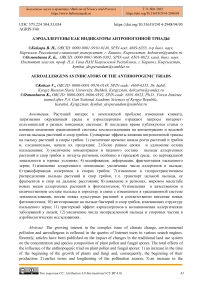Аэроаллергены как индикаторы антропогенной триады
Автор: Кобзарь В.Н., Осмонбаева К.Б.
Журнал: Бюллетень науки и практики @bulletennauki
Рубрика: Биологические науки
Статья в выпуске: 9 т.9, 2023 года.
Бесплатный доступ
Растущий интерес к комплексной проблеме изменения климата, загрязнения окружающей среды и аэроаллергенам отражают запросы интернет-пользователей в разных поисковых системах. В последнее время публикуются статьи о влиянии изменения традиционной системы землепользования на концентрацию и видовой состав пыльцы растений и спор грибов. Суммарные эффекты влияния антропогенной триады на пыльцу растений и споры грибов: 1) увеличение времени начала роста растений и грибов и, следовательно, начала их продукции; 2) более раннее сроки и удлинение сезона пыльцевания; 3) увеличение концентрации и видового состава пыльцы аллергенных растений и спор грибов в воздухе регионов, особенно в городской среде, по вертикальной зональности в горных условиях; 4) модификация, деформация, фрагментация пыльцевого зерна; 5) изменение аллергенного потенциала: увеличение числа аллергенов в пыльце; 6) трансформация аллергенов в спорах грибов; 7) изменение в геопространственном распределении пыльцы растений и спор грибов, т. е. транспорт цельной пыльцы, ее фрагментов и спор на дальние расстояния; 8) появление в регионах, мировом масштабе новых видов аллергенных растений и фитопатогенов; 9) изменения в качественном и количественном составе пыльцы и аэроспор, в связи с изменением в традиционной системе землепользования, посеве новых культурных растений и соответственно внесение новых фитопатогенов; 10) вегетирование на пыльце бактерий и спор грибов, изменяющих структуру пыльцевого зерна; 11) триггерный эффект аэроаллергенов в возникновении аллергических заболеваний у людей; 12) увеличение числа неопределенной пыльцы и споровых частиц в аэробиологических исследованиях.
Пыльца растений, споры грибов, поллинозы, изменение климата, изменение системы землепользования, загрязнения окружающей среды, урбанизация
Короткий адрес: https://sciup.org/14128700
IDR: 14128700 | УДК: 575.224 | DOI: 10.33619/2414-2948/94/05
Текст научной статьи Аэроаллергены как индикаторы антропогенной триады
Бюллетень науки и практики / Bulletin of Science and Practice
UDC 575.224 504.53.054
Растущий интерес к комплексной проблеме изменения климата, загрязнения окружающей среды и аэроаллергенам отражают запросы интернет-пользователей в разных поисковых системах. В последнее время публикуются статьи о влиянии изменения землепользования на концентрацию и видовой состав пыльцы растений и спор грибов. Особенно много результатов исследований и систематических обзоров опубликовано на английском языке. С учетом актуальности и социальной значимости, целью настоящей статьи является модификация ранее выдвинутой концепции [1] в рамках концепции «Единое здоровье». Суть концепции «Единое здоровье» заключается в том, что здоровье людей, животных и экосистем взаимосвязано, поэтому она принята как на национальном, так и на глобальном уровнях. Она включает в себя применение скоординированного, совместного, междисциплинарного и межсекторального подхода для устранения потенциальных или существующих рисков, возникающих на стыке, окружающая среда – животное – человек – экосистемы. Новое название разработанной концепции — «Аэроаллергены как индикаторы антропогенной триады: изменения климата и системы землепользования; загрязнения окружающей среды» (Рисунок 1).
Считают, что сложные взаимодействия между концентрацией пыльцы, метеорологическими переменными и загрязнителями воздуха в меняющемся климате до сих пор недостаточно изучены [2]. Изменение климата является физико-метеорологическим фактом и, помимо его других последствий, влияет на здоровье человека, в особенности на клинические проявления аллергических заболеваний [3].
Из-за изменения климата и загрязнения среды обитания человека концентрация в атмосфере таких триггерных факторов, как пыльца и споры прогрессивно увеличивается и вызывает аллергический ринит и бронхиальную астму у сенсибилизированных больных [4].
Пыльца растений как ведущая причина поллиноза является одним из основных компонентов в составе атмосферного биоаэрозоля. Изменение климата влияет как на начало, продолжительность и серьезность пыльцевого сезона, так и на структуру пыльцевого зерна. С повышением уровня CO 2 увеличивается фотосинтез и пыльцепродуктивность растений.
Изменение климата
Изменение

П ыльца растений
землепользования
Загрязнение окружающей среды
АЭРОАЛЛЕРГЕНЫ
Споры грибов
Дальний перенос пыльцы, распространение новых видов
Дальний перенос спор, распространение новых видов ч_________________________________________>
Изменение сроков пыления: начала и продолжительности f Изменение структуры зерна: деформация, фрагментация, модификация, увеличение числа аллергенов
Изменение сроков вегетации, вегетирование на пыльце
Т рансформация спор
Утяжеление симптомов и
продолжительности поллиноза и пыльцевой
Триггерный эффект в возникновении аллергических заболеваний у людей
астмы
Рисунок 1. Схема концепции «Аэроаллергены как индикаторы антропогенной триады»
Во время развития в пыльнике и при рассеивании пыльцы в окружающей среде на нее воздействует комплекс метеорологических условий и загрязнителей воздуха, тем самым усиливая тяжесть клинических проявлений аллергического ринита и бронхиальной астмы. Одним из таких факторов риска развития поллинозов является количество вдыхаемой аллергенной пыльцы, зависимое от таксона аллергенных растений. Общепринятые показатели аэроаллергенов соответствующие симптомам поллиноза разного уровня представлены в Таблице.
Исходя из этих данных, можно высчитать ту или иную пороговую аллергенную нагрузку, которой подвергаются больные в определенном регионе. Цельные пыльцевые зерна размером 10 мкм могут легко проникать в верхние отделы дыхательной системы и сенсибилизировать организм, но только фрагменты пыльцы достигают альвеол легких, вызывая симптомы пыльцевой бронхиальной астмой. Известно, что дождь очищает воздух от пыльцы, но при контакте ее с водой, содержащиеся в ней аллергены, высвобождаются всего за несколько секунд [5–8]. Под воздействием экстремальных погодных явлений (проливные дожди и грозы) пыльцевые зерна деградируют на так называемые полимикронные частицы. Они представлены гранулами диаметром менее 5 мкм, значительное число аллергенов в них содержащихся, негативно воздействует на аллергиков и астматиков [9]. Предполагаемые механизмы фрагментации пыльцы во время грозы включают механическое трение от порывов ветра, накопление электричества и разряд, возникающие в условиях низкой относительной влажности, а также удары молнии [10].
Таблица
ГРАДАЦИЯ УРОВНЯ ПЫЛЬЦЫ РАСТЕНИЙ И СПОР ГРИБОВ В ВОЗДУХЕ (м3)
|
Концентрация аэроаллергенов |
Симптоматика поллиноза |
Изображения пыльцы и спор под сканирующим электронным микроскопом |
|
|
Споры грибов |
|||
|
1. |
0–6 499 |
Низкий |
|
|
2. |
6 500–12 999 |
Средний |
|
|
3. |
13 000–49 999 |
Высокий |
|
|
4. |
>50 000 |
Очень высокий |
|
|
Пыльца злаков |
|||
|
1. |
0–4 |
Низкий |
|
|
2. |
5–19 |
Средний |
|
|
3. |
20–199 |
Высокий |
|
|
4. |
>200 |
Очень высокий |
|
|
Пыльца деревьев |
|||
|
1. |
0–14 |
Низкий |
|
|
2. |
15–89 |
Средний |
|
|
3. |
90–1 499 |
Высокий |
|
|
4. |
>1 500 |
Очень высокий |
|
|
Пыльца сорняков |
|||
|
1. |
0– 9 |
Низкий |
AflB№r |
|
2. |
10–49 |
Средний |
|
|
3. |
50–499 |
Высокий |
|
|
4. |
>500 |
Очень высокий |
Воздушные пыльца растений и споры грибов вносят значительный вклад в неблагоприятные последствия для здоровья человека. Они являются ключевыми триггерами аллергического риноконъюнктивита и обострений бронхиальной астмы. Увеличение концентрации аэроспор, связанное с обильными осадками и высокими температурами, увеличивает риск аллергической сенсибилизации. Как правило, разные больные чувствительны к варьирующим уровням аэроаллергенов, поэтому важно понимать, как со временем меняется аллергенная активность пыльцы и спор. По прогнозу сценария будущего климата SSP 585 сезон пыльцы начнется раньше (до 40 дней) и удлинится (+19 дней) с изменением температуры, а годовая общая эмиссия пыльцы также увеличится (16–40 дней). Изменения, обусловленные только климатом, относительно невелики (от -35 до 40%) по сравнению с большим максимальным увеличением выбросов (до 200%) при учете увеличения содержания CO 2 в пыльцевой продукции [11].
Показано, что модели эмиссии пыльцы, параметры будущих климатических данных, более высокие температуры смещают начало весенней эмиссии на 10–40 дней раньше, а летне-осенние сорные и злаковые травы — на 5–15 дней позже и удлиняют продолжительность сезона. Температура и осадки изменяют максимумы дневной эмиссии пыльцы от -35 до 40% и увеличивают общую годовую эмиссию пыльцы на 16–40% из-за изменений в фенологии и продукции. Вклад изменения системы землепользования в распределение источников пыльцы относительно невелик (<10%), по сравнению с изменением климата или CO 2 [12].
За последние несколько десятилетий более высокие температуры привели к раннему
(на 3–22 дня) началу сезона пыльцы [13–15] для весеннецветущих таксонов деревьев ( Betula , Quercus и Acer ), в то время как позднецветущие таксоны ( Artemisia и сорные травы, доминирующие летом и осенью) начинают пылить на 27 дней позже [13, 16].
Географическое распространение аллергенных видов растений также связано с изменением климата. Вслед за повышением температур, количества осадков и других факторов ареал многих растений (например, амброзии и дурнишника) может сместиться к полюсам, т. е. к северу в бореальном полушарии и к югу в южном полушарии. На распределение злаковых трав в растительном покрове также могут повлиять изменения в традиционной системе землепользования и, в целом, антропогенная деятельность [17, 18].
В настоящее время сельское хозяйство оказывает положительное влияние на распространение субтропических трав в дополнение к изменению климата, что способствует росту популяций растений и их распространению в ранее необычных местах. Так, Австралия и Аргентина входят в число стран с постоянно растущими площадями, отведенными под сельское хозяйство, что, безусловно, может иметь последствия в отношении аллергии [19– 21]. Такая же тенденция установлена в Иссык-Кульской области Киргизии [20].
Более высокая заболеваемость поллинозами была зафиксирована у городских жителей, по сравнению с сельскими. Она связана с высоким уровнем выбросов автотранспорта, урбанизации и западного образа жизни [22]. Утрата биоразнообразия, изменение климата, загрязнение и микробиом взаимосвязаны, и этот рост аллергии в городской среде также может быть связан с его сокращением [23, 24].
Загрязнители воздуха органической природы способны прилипать к поверхности экзины пыльцевых зерен и микронным частицам растительного происхождения, повышая их аллергенность и различным образом влияя на палиноморфологию [25].
Кроме того, загрязняющие вещества, адсорбированные на поверхности экзины пыльцевых зерен, могут преодолевать слизистый барьер вследствие воспаления и повышенной проницаемости дыхательных путей, вызывая усиленный ответ у больных поллинозом [26–28].
Уровни озона и других загрязнителей воздуха повышаются за счет эффекта городского острова тепла, который также оказывает косвенное влияние на природные явления, вызывающие выбросы частиц, такие как лесные пожары, эрозия почвы и разрушение растительности [29, 30].
Наблюдаемое и прогнозируемое воздействие изменения климата на аэроаллергены включает вариации в их продукции и концентрации в атмосфере, сдвиги во времени и продолжительности пыльцевого сезона, модификации аллергенности пыльцы и спор, а также изменения в географическом и пространственном распределении аэроаллергенов и самих растений [31].
Авторы, изучая концентрацию аэроспор Cladosporium и Alternaria за 26-летний период (1990–2015 гг.) в Копенгагене, обнаружили тенденцию к снижению изолированного сезонного интеграла спор Alternaria и годовых пиковых концентраций тандема Alternaria и Cladosporium. Хотя температура за этот период повысилась, они объяснили выявленную тенденцию растущей урбанизацией и изменениями в методах ведения сельского хозяйства [32].
Анализ таксонов пыльцы из 17 мест на трех континентах в Северном полушарии с долгосрочными записями показал, что в 12 из 17 мест повысились сезонная кумулятивная или годовая пыльцевые нагрузки, а в 11 из 17 мест увеличилась продолжительность сезона пыльцы с течением времени [33].
Это было связано с повышением температуры в соответствующих местах. Следует учитывать, что воздействия изменения климата на аллергические заболевания проявляется как при взаимодействии между аэроаллергенами и загрязнителями воздуха, так и при прямом или косвенном влиянии на загрязнители. Загрязнение воздуха оказывает эффект действия на пыльцу растений в пыльнике и непосредственном в воздухе, может воздействовать синергетически с ее аллергенными детерминантами, усиливая риск развития аллергических заболеваний [34]. Озон, оксиды азота и взвешенные частицы в воздухе, связанные с горением или дорожным движением, могут увеличить количество и модифицировать аллергены, действовать как адъюванты и изменять иммуногенность аллергенных белков [35].
Мониторинг аэроаллергенов уже давно считается исследователями ключевым индикатором состояния окружающей среды для изменения климата [36]. В связи с признанием взаимодействия физических, химических и биологических аспектов атмосферы, необходим комплексный подход не только к мониторингу и оценке, но также к прогнозированию и информированию населения о качестве воздуха [37].
Авторы предлагают, чтобы показатель аллергенного потенциала пыльцы, свидетельствующий о повышении ее аллергенности в результате загрязнения, можно рассматривать в качестве нового индикатора риска для респираторного здоровья в городских районах [38, 39].
Пыльцевое зерно имеет сложную архитектонику, в которой аллергенные белки пыльцы встроены в гетерогенную матрицу многих биоактивных молекул, доставляя их одновременно во время аллергической сенсибилизации. В пыльцевом зерне выделяют: внутреннюю оболочку (интину), которая представлена белками, метаболитами, липидами, аденозином, флавоноидами и наружную скульптурированную (экзину), включающую вирусы, бактерии, споры грибов и частицы загрязнителей воздуха (Рисунок 2) [40].
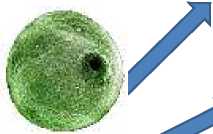
Адсорбция пыли и других частичек на экзине
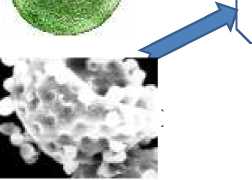
Фрагменты пыльцы


Фагоцитоз, активация Thl
Фагоцитоз, активация Thl
Фагоцитоз, активация ТЫ, повреждение эпителия
Вегетирование бактерий, спор ^ грибов на экзине
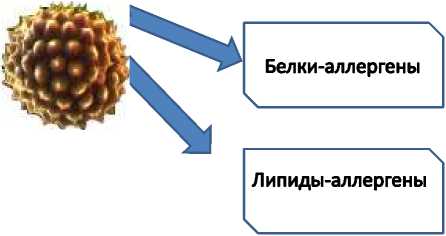


активация Th2, повреждение эпителия
Активация Th2, рекрутирование нейтрофилов и эозинофилов
Ри астений
Метагеномное исследование пыльцевого микробиома демонстрирует наличие более тысячи различных видов бактерий, обитающих на пыльцевых зернах анемофильных растений, включая березу и злаковые травы. Культивируемые бактерии, составляющие лишь 5% всех бактерий, вегетирующие на пыльцевых зернах березы, имеют более 106 клеток на грамм пыльцы [41]. Палиноморфологические исследования методом сканирующей электронной микроскопии выявили биопленки, образованные колониями бактерий и грибов [42, 43].
Кроме того, пыльца амброзии, собранная вдоль дорог с интенсивным движением, показала более высокую аллергенность, чем пыльца растений, произрастающая на участках с естественной растительностью. Общее воздействие будет заключаться в изменении сроков и нагрузки пыльцевого сезона и, следовательно, в изменении экспозиции [44].
Наряду с аллергенными белками пыльца растений и споры грибов содержат и другие соединения, которые могут действовать как адъюванты. Высвобождение этих неаллергенных, но биоактивных липидных медиаторов, может вызывать и усиливать аллергию. Установлено, что на выброс этих веществ влияет загрязнение воздуха, причем значительно более высокие уровни присутствуют в пыльце, собранной в районах с интенсивным движением транспорта (Рисунок 3).
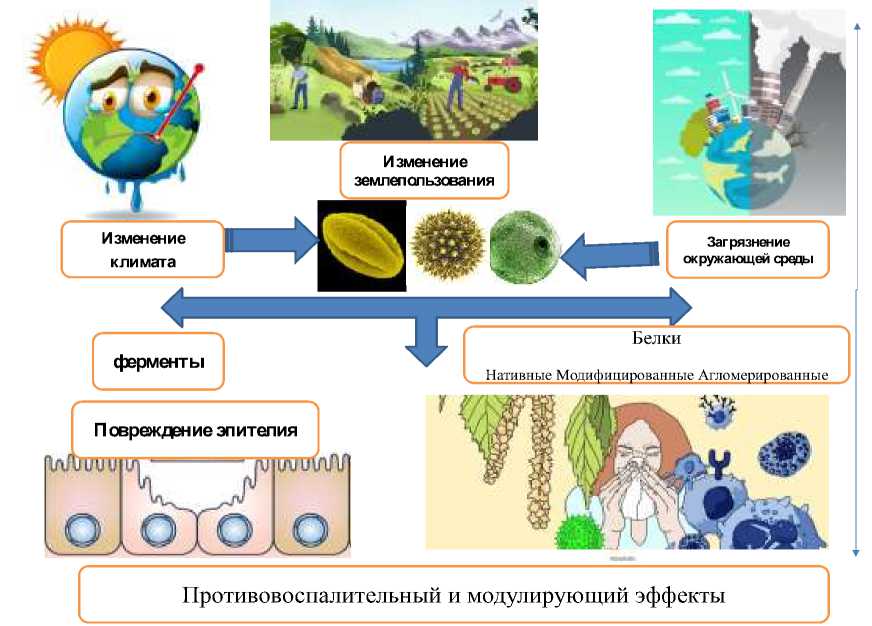
Рисунок 3. Взаимосвязь процессов
Исходя из анализа источников литературы и собственных исследований, мы суммировали основные эффекты влияния антропогенной триады: изменения климата, системы землепользования и урбанизации, загрязнения среды обитания человека на пыльцу растений [45–50]: 1) увеличение времени начала роста растений и, следовательно, начала пыльцепродукции; 2) более раннее сроки и удлинение сезона пыльцевания; 3) увеличение концентрации и видового состава пыльцы аллергенных растений в воздухе регионов, особенно в городской среде, по вертикальной зональности в горных условиях;
4) модификация, деформация, фрагментация пыльцевого зерна; 5) изменение аллергенного потенциала: увеличение числа аллергенов, содержащихся в пыльце; 6) изменение в геопространственном распределении пыльцы, т. е. транспорт цельной пыльцы растений и ее фрагментов на дальние расстояния; 7) появление в регионах, мировом масштабе новых видов аллергенных растений; 8) изменения в качественном и количественном составе пыльцы аллергенных растений, в особенности злаковых трав, в связи с изменением в системе землепользования; 9) вегетирование на пыльце бактерий и спор грибов, изменяющих структуру пыльцевого зерна; 10) увеличение числа неопределенной пыльцы в аэробиологических исследованиях.
Основные эффекты влияния антропогенной триады: изменения климата и системы землепользования, урбанизации и загрязнения окружающей среды на споры грибов [44–50]: колонизация и рост грибов; перенос спор грибов на значительные расстояния; повышение количественных тенденций в концентрации аэроспор; трансформация аллергенов в спорах грибов; появление в аэромикологичеком спектре регионов новых видов спор грибов; изменения в качественном и количественном составе аэроспор, в связи с изменением в традиционной системе землепользования, посеве новых культурных растений и соответственно внесение новых фитопатогенов; триггерный эффект в возникновении аллергических заболеваний у людей; увеличение числа неопределенных споровых частиц в аэробиологических исследованиях.
Заключение
Доказательства воздействия изменения климата и традиционной системы землепользования, а также загрязнения среды обитания человека на продуктивность, концентрацию аэроаллергенов, сезонность, распределение и увеличение их аллергенного потенциала продолжают накапливаться и заполнять пробелы, которые остаются в наших знаниях по этой сложной комплексной теме. Изменение климата, урбанизация, связанная с загрязнением окружающей среды совместно способствуют изменчивости характеристик аэроаллергенов, приводя к растущему числу больных поллинозами и бронхиальной астмой.
Одной из эффективных мер является повышение осведомленности населения о проблеме и принятие правительственных решений по предотвращению загрязнения окружающей среды и изменения климата во всем мировом сообществе. Меры по адаптации и смягчению последствий могут быть приняты для ограничения воздействия изменения климата на загрязнение воздуха, вызванное химическими и биологическими агентами. С одной стороны, эта мера направлена на устранение причин изменения климата (парниковых газов в атмосфере), а адаптация способствует устранению выявленных последствий. С другой стороны, адаптация не сможет устранить всех негативные последствия, и смягчение последствий имеет решающее значение для ограничения изменений в климатической системе. Экстремальные погодные явления, такие как грозы, способствуя фрагментации пыльцы, вызывают обострения и утяжеление форм бронхиальной астмы с негативными социально-экономическими последствиями.
Список литературы Аэроаллергены как индикаторы антропогенной триады
- Кобзарь В. Н., Осмонбаева К. Б. Концепция: аэроаллергены как индикаторы изменения климата и загрязнения окружающей среды // Медицина Кыргызстана. 2017. №4. C. 30-33.
- Oh J. W. Pollen allergy in a changing planetary environment // Allergy, Asthma & Immunology Research. 2022. V. 14. №2. P. 168-181. https://doi.org/10.4168%2Faair.2022.14.2.168
- Anenberg S. C., Haines S., Wang E., Nassikas N., Kinney P. L.Synergistic health effects of air pollution, temperature, and pollen exposure: a systematic review of epidemiological evidence // Environmental Health. 2020. V. 19. P. 1-19. https://doi.org/10.1186/s12940-020-00681-z
- D’Amato G., D’Amato M. Climate change, air pollution, pollen allergy and extreme atmospheric events // Current Opinion in Pediatrics. 2023. V. 35. №3. P. 356-361. https://doi.org/10.1097/MOP.0000000000001237
- Paudel B., Chu T., Chen M., Sampath V., Prunicki M., Nadeau K. C. Increased duration of pollen and mold exposure are linked to climate change // Scientific reports. 2021. V. 11. №1. P. 12816. https://doi.org/10.1038/s41598-021-92178-z
- Brown J., Bowman C. Integrated science assessment for ozone and related photochemical oxidants // US Environmental Protection Agency. 2013.
- Kim S. Y., Kim E., Kim W. J. Health effects of ozone on respiratory diseases // Tuberculosis and Respiratory Diseases. 2020. V. 83. №Supple 1. P. S6. https://doi.org/10.4046%2Ftrd.2020.0154
- Cosselman K. E., Navas-Acien A., Kaufman J. D. Environmental factors in cardiovascular disease // Nature Reviews Cardiology. 2015. V. 12. №11. P. 627-642. https://doi.org/10.1038/nrcardio.2015.152
- Kinney P. L. Interactions of climate change, air pollution, and human health // Current environmental health reports. 2018. V. 5. P. 179-186. https://doi.org/10.1007/s40572-018-0188-x
- Emmerson K. M., Silver J. D., Thatcher M., Wain A., Jones P. J., Dowdy A., Bannister T. Atmospheric modelling of grass pollen rupturing mechanisms for thunderstorm asthma prediction // PloS one. 2021. V. 16. №4. P. e0249488. https://doi.org/10.1371/journal.pone.0249488
- Ziska L. H., Caulfield F. A. Rising CO2 and pollen production of common ragweed (Ambrosia artemisiifolia L.), a known allergy-inducing species: implications for public health // Functional Plant Biology. 2000. V. 27. №10. P. 893-898. https://doi.org/10.1071/PP00032
- Zhang Y., Steiner A. L. Projected climate-driven changes in pollen emission season length and magnitude over the continental United States // Nature communications. 2022. V. 13. №1. P. 1234. https://doi.org/10.1038/s41467-022-28764-0
- Seth D., Bielory L. Allergenic pollen season variations in the past two decades under changing climate in the United States // Immunology and Allergy Clinics. 2021. V. 41. №1. P. 17-31. https://doi.org/10.1016/j.iac.2020.09.006
- Šikoparija B., Skjøth C. A., Radišić P., Apatini D., Magyar D., Páldy A., Smith M. Variation in Artemisia pollen seasons in Central and Eastern Europe // Agricultural and Forest Meteorology. 2012. V. 160. P. 48-59. https://doi.org/10.1016/j.agrformet.2012.02.013
- Van Vliet A. J., Overeem A., De Groot R. S., Jacobs A. F., Spieksma F. T. The influence of temperature and climate change on the timing of pollen release in the Netherlands // International Journal of Climatology: A Journal of the Royal Meteorological Society. 2002. V. 22. №14. P. 1757- 1767. https://doi.org/10.1002/joc.820
- Emberlin J., Detandt M., Gehrig R., Jaeger S., Nolard N., Rantio-Lehtimäki A. Responses in the start of Betula (birch) pollen seasons to recent changes in spring temperatures across Europe // International Journal of Biometeorology. 2002. V. 46. P. 159-170. https://doi.org/10.1007/s00484-002-0139-x
- Marco M., Paola D. M., Alfonso C., Marzia O., Simone O. Long distance transport of ragweed pollen as a potential cause of allergy in central Italy // Annals of Allergy, Asthma & Immunology. 2006. V. 96. №1. P. 86-91. https://doi.org/10.1016/S1081-1206(10)61045-9
- Кобзарь В. Н., Осмонбаева К. Б. Влияние изменения землепользования на аэромикологический спектр. // Бюллетень науки и практики. 2018. Т.4. 11. С. 51–60. https://doi.org/10.1093/cdn/nzaa087
- Gornall J., Betts R., Burke E., Clark R., Camp J., Willett K., Wiltshire A. Implications of climate change for agricultural productivity in the early twenty-first century // Philosophical Transactions of the Royal Society B: Biological Sciences. 2010. V. 365. №1554. P. 2973-2989. https://doi.org/10.1098/rstb.2010.0158
- García-Mozo H., Oteros J. A., Galán C. Impact of land cover changes and climate on the main airborne pollen types in Southern Spain // Science of the Total Environment. 2016. V. 548. P. 221-228. https://doi.org/10.1016/j.scitotenv.2016.01.005
- Raiten D. J., Allen L. H., Slavin J. L., Mitloehner F. M., Thoma G. J., Haggerty P. A., Finley J. W. Understanding the intersection of climate/environmental change, health, agriculture, and improved nutrition: a case study on micronutrient nutrition and animal source foods // Current developments in nutrition. 2020. V. 4. №7. P. nzaa087.
- d’Amato G., Annesi-Maesano I., Urrutia-Pereira M., Del Giacco S., Rosario Filho N. A., Chong-Neto H. J., d’Amato M. Thunderstorm allergy and asthma: state of the art // Multidisciplinary Respiratory Medicine. 2021. V. 16. №1. https://doi.org/10.4081%2Fmrm.2021.806
- Haahtela T. A biodiversity hypothesis //Allergy. 2019. V. 74. №8. P. 1445-1456. https://doi.org/10.1111/all.13763
- Haahtela T., Holgate S., Pawankar R., Akdis C. A., Benjaponpitak S., Caraballo L., von Hertzen L. The biodiversity hypothesis and allergic disease: world allergy organization position statement // World Allergy Organization Journal. 2013. V. 6. P. 3. https://doi.org/10.1186/1939-4551-6-3
- D’amato G., Cecchi L. Effects of climate change on environmental factors in respiratory allergic diseases // Clinical & Experimental Allergy. 2008. V. 38. №8. P. 1264-1274. https://doi.org/10.1111/j.1365-2222.2008.03033.x
- Kreit J. W., Gross K. B., Moore T. B., Lorenzen T. J., D’Arcy J. A., Eschenbacher W. L. Ozone-induced changes in pulmonary function and bronchial responsiveness in asthmatics // Journal of applied physiology. 1989. V. 66. №1. P. 217-222. https://doi.org/10.1152/jappl.1989.66.1.217
- Scannell C., Chen L., Aris R. M., Tager I., Christian D., Ferrando R., Balmes J. R. Greater ozone-induced inflammatory responses in subjects with asthma // American journal of respiratory and critical care medicine. 1996. V. 154. №1. P. 24-29. https://doi.org/10.1164/ajrccm.154.1.8680687
- Bayram H., Sapsford R. J., Abdelaziz M. M., Khair O. A. Effect of ozone and nitrogen dioxide on the release of proinflammatory mediators from bronchial epithelial cells of nonatopic nonasthmatic subjects and atopic asthmatic patients in vitro // Journal of Allergy and Clinical Immunology. 2001. V. 107. №2. P. 287-294. https://doi.org/10.1067/mai.2001.111141
- Bernard S. M., Samet J. M., Grambsch A., Ebi K. L., Romieu I. The potential impacts of climate variability and change on air pollution-related health effects in the United States // Environmental health perspectives. 2001. V. 109. №suppl 2. P. 199-209. https://doi.org/10.1289/ehp.109-1240667
- Confalonieri U., Menne B., Akhtar R., Ebi K. L., Hauengue M., Kovats R. S., Woodward A. Human health // Climate change 2007: impacts, adaptation and vulnerability: contribution of Working Group II to the fourth assessment report of the Intergovernmental Panel on Climate Change. 2007. http://hdl.handle.net/2292/14073
- Beggs P. J. Climate change, aeroallergens, and the aeroexposome // Environmental Research Letters. 2021. V. 16. №3. P. 035006. https://doi.org/10.1088/1748-9326/abda6f
- Olsen Y., Skjøth C. A., Hertel O., Rasmussen K., Sigsgaard T., Gosewinkel U. Airborne Cladosporium and Alternaria spore concentrations through 26 years in Copenhagen, Denmark // Aerobiologia. 2020. V. 36. P. 141-157. https://doi.org/10.1007/s10453-019-09618-7
- Ziska L. H., Makra L., Harry S. K., Bruffaerts N., Hendrickx M., Coates F., Crimmins A. R. Temperature-related changes in airborne allergenic pollen abundance and seasonality across the northern hemisphere: a retrospective data analysis // The Lancet Planetary Health. 2019. V. 3. №3. P. e124-e131. https://doi.org/10.1016/S2542-5196(19)30015-4
- Beggs P. J. (ed.). Impacts of climate change on allergens and allergic diseases. – Cambridge University Press, 2016.
- Reinmuth-Selzle K., Kampf C. J., Lucas K., Lang-Yona N., Fröhlich-Nowoisky J., Shiraiwa M., Pöschl U. Air pollution and climate change effects on allergies in the anthropocene: abundance, interaction, and modification of allergens and adjuvants // Environmental science & technology. 2017. V. 51. №8. P. 4119-4141. https://doi.org/10.1021/acs.est.6b04908
- English P. B., Sinclair A. H., Ross Z., Anderson H., Boothe V., Davis C., Simms E. Environmental health indicators of climate change for the United States: findings from the State Environmental Health Indicator Collaborative // Environmental health perspectives. 2009. V. 117. №11. P. 1673-1681. https://doi.org/10.1289/ehp.0900708
- Klein T., Kukkonen J., Dahl Å. et al. Interactions of physical, chemical, and biological weather calling for an integrated approach to assessment, forecasting, and communication of air quality. // AMBIO. 2012. 41. P.851–864. https://doi.org/10.1007/s13280-012-0288-z
- Schiavoni G., D'Amato G., Afferni C. The dangerous liaison between pollens and pollution in respiratory allergy // Annals of Allergy, Asthma & Immunology. 2017. V. 118. №3. P. 269-275. https://doi.org/10.1016/j.anai.2016.12.019
- Guryanova S. V., Finkina E. I., Melnikova D. N., Bogdanov I. V., Bohle B., Ovchinnikova T. V. How Do Pollen Allergens Sensitize? // Frontiers in Molecular Biosciences. 2022. V. 9. P. 900533. https://doi.org/10.3389/fmolb.2022.900533
- Gilles S., Behrendt H., Ring J., Traidl-Hoffmann C. The pollen enigma: modulation of the allergic immune response by non-allergenic, pollen-derived compounds // Current pharmaceutical design. 2012. V. 18. №16. P. 2314-2319. https://doi.org/10.2174/138161212800166040
- Alibrandi P., Schnell S., Perotto S., Cardinale M. Diversity and structure of the endophytic bacterial communities associated with three terrestrial orchid species as revealed by 16S rRNA gene metabarcoding // Frontiers in Microbiology. 2020. V. 11. P. 604964. https://doi.org/10.3389/fmicb.2020.604964
- Kalkar Surekha A., Renu J. Effects of industrial pollution on pollen morphology of Cassia species // International journal of Life Sciences. 2014. V. 2. №1. P. 17-22.
- Кобзарь В. Н. Стратегия загрязнения пыльцы Artemisia и Chenopodiaceae // Бюллетень науки и практики. 2021. Т. 7. №2. С. 10-28. https://doi.org/10.33619/2414- 2948/63/01
- D’Amato G., Vitale C., Rosario N., Neto H. J. C., Chong-Silva D. C., Mendonça F., D’Amato M. Climate change, allergy and asthma, and the role of tropical forests // World Allergy Organization Journal. 2017. V. 10. №1. P. 1-8. https://doi.org/10.1186/s40413-017-0142-7
- Singh A. B., Kumar P. Climate change and allergic diseases: An overview // Frontiers in Allergy. 2022. V. 3. P. 964987. https://doi.org/10.3389/falgy.2022.964987
- D’Amato G., Chong-Neto H. J., Monge Ortega O. P., Vitale C., Ansotegui I., Rosario N., ... & Annesi-Maesano I. The effects of climate change on respiratory allergy and asthma induced by pollen and mold allergens // Allergy. 2020. V. 75. №9. P. 2219-2228. https://doi.org/10.1111/all.14476
- D’Amato G., Akdis C. Global warming, climate change, air pollution and allergies // Authorea Preprints. 2020.
- D’Amato G., Holgate S. T., Pawankar R., Ledford D. K., Cecchi L., Al-Ahmad M., Annesi-Maesano I. Meteorological conditions, climate change, new emerging factors, and asthma and related allergic disorders. A statement of the World Allergy Organization // World allergy organization journal. 2015. V. 8. №1. P. 1-52. https://doi.org/10.1186/s40413-015-0073-0
- D’amato G., Pawankar R., Vitale C., Lanza M., Molino A., Stanziola A., D'amato M. Climate change and air pollution: effects on respiratory allergy // Allergy, asthma & immunology research. 2016. V. 8. №5. P. 391-395. https://doi.org/10.4168/aair.2016.8.5.391
- D’Amato G., Vitale C., Lanza M., Molino A., D’Amato M. Climate change, air pollution, and allergic respiratory diseases: an update // Current opinion in allergy and clinical immunology. 2016. V. 16. №5. P. 434-440. https://doi.org/10.1097/ACI.0000000000000301

